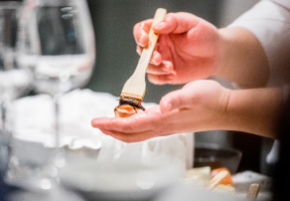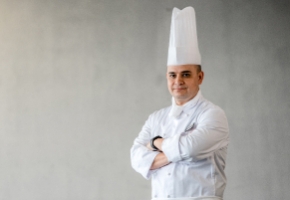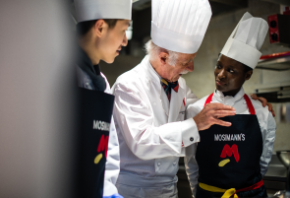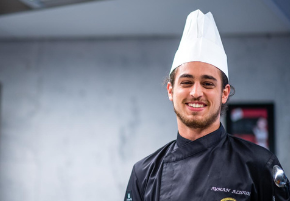- About
- Programs
- Campus Life
- Career Services
- Admissions
- News & Events
- Alumni
How to Cook Lobster for a Fine Dining Meal
Find out how to cook lobster the right way with easy, reliable techniques that preserve its natural flavor and keep the texture just right.
Key Takeaways
- The global lobster market has reached a value of 7.5 billion euros, reflecting its strong demand and popularity in the hospitality and fine dining industries.
- Boiling, steaming, and sous-vide are all excellent lobster cooking methods, each offering a different texture and flavor experience.
- Proper handling, humane preparation, and the right tools help preserve both flavor and presentation.
- With the right knowledge and steps, cooking lobster becomes an accessible and rewarding fine dining experience.
Lobster has long held its place as a centerpiece in fine dining, celebrated for its sweet, tender meat and its reputation as a premium ingredient around the world. Driven by an increased demand in hospitality, the global lobster market was valued at 7.5 billion euros in 2024, as chefs value it for its elegance and flavor.
Learning how to cook lobster not only deepens your culinary skills but also brings an impressive, restaurant-quality touch to your own kitchen.
You might be planning a romantic dinner, hosting a dinner party, or treating yourself to something special; in any event, preparing lobster can be a rewarding experience. It may seem daunting at first, but with a little guidance, the process becomes surprisingly approachable.
How to Choose the Right Lobster
Choosing the right lobster sets the foundation for an exceptional fine dining experience. The perfect specimen ensures both superior taste and presentation, elevating your dish from ordinary to memorable.
There are two main types of lobster you can choose from:
- American (Homarus americanus): Found along the Atlantic coast, prized for its sweet, firm meat.
- European (Homarus gammarus): Native to northeastern waters, known for its delicate flavor and slightly gelatinous texture.
Selecting the right weight and size matters. Smaller lobsters (450 to 570 grams, or 1 to 1¼ pounds) cook quickly and have tender meat ideal for sautéing or pasta. Larger ones (900 grams or more, around 2 pounds and up) yield more meat but require longer cooking times.
Freshness also matters greatly. Look for lively lobsters that respond when touched, with a firm tail curl, clean shell, and clear eyes. These signs confirm health and high quality.
To expertly source lobster:
- Purchase from reputable fishmongers with high turnover.
- Ask about catch date and storage methods.
- Consider sustainable certification to support eco‑friendly fisheries.
Transport and storage must follow proper standards. The Swiss lobster ruling, effective March 2018, requires lobsters to be kept in a natural environment, rather than on ice, and to be stunned before cooking. At Culinary Arts Academy Switzerland (CAAS), students learn to respect this rule by discussing humane handling and adapting their techniques accordingly. This training prepares chefs to deliver excellence with integrity in every lobster dish they serve.
Steps to Prepare the Lobster
Preparing a live lobster requires care, confidence, and respect for the ingredient. Always handle it gently and with purpose. Hold the lobster from the back, gripping the body behind the claws to avoid injury. Keep it over a sink or tray to manage any sudden movement or drips.
Before cooking, it’s essential to follow humane practices. The goal is to minimize stress and pain. The most widely accepted methods include:
- Stunning: Some kitchens use electrical stunning devices where available.
- Splitting: Place the chilled lobster belly-down on a stable surface. Using a sharp chef’s knife, locate the cross on the head and swiftly split down through it, then continue through the body.
Before proceeding, remove any rubber bands or ID tags from the claws. These are not heat-safe and may affect flavor during cooking.
Trimming is not always required. For boiling or steaming, keep the lobster whole. If roasting or grilling, trimming the antennae or separating the claws can make handling easier and improve presentation. Always follow your recipe’s guidelines for the best result.
How to Cook Lobster: Key Methods
Start Your Culinary Journey
Learn the art of cooking in a world-class environment
There is no single “right” way to cook lobster. The cooking method you choose can bring out different textures and subtle shifts in flavor. Boiling is quick and convenient, steaming preserves delicate sweetness, and sous-vide offers restaurant-level precision. Many chefs master all three to match the method with the dish.
Boiling lobster
Boiling is a classic and beginner-friendly way to cook lobster. It’s fast, straightforward, and ideal when serving lobster whole or in chilled salads. It’s especially useful when preparing several lobsters at once.
Use a large pot and aim for about three liters of salted water per lobster.
Timing depends on weight:
- 450–500 g lobster (1 pound): 8–10 minutes
- 675–700 g (1½ pounds): 11–12 minutes
- 900 g–1 kg (2 pounds): 15 minutes
Steps to boil a lobster:
- Fill a large pot with enough water to cover the lobster(s).
- Add two tablespoons of salt per liter.
- Bring the water to a rolling boil.
- Grasp the lobster firmly and lower it headfirst into the pot.
- Cover with a lid and start timing immediately.
- Once cooked, remove and place the lobster in a bowl of ice water for 1 minute to stop the cooking.
Steaming lobster
Steaming offers a more refined result than boiling. Because the lobster doesn’t sit directly in water, more natural flavor stays inside the shell. The meat turns out tender, juicy, and full of its briny sweetness. Steaming is great when serving lobster hot with melted butter or chilled in elegant seafood dishes.
Use a pot large enough to fit a steamer rack and the lobsters. Add about 5 cm (2 inches) of water to the bottom and bring it to a boil.
Steaming times also vary:
- 450–500 g lobster (1 pound): 10–11 minutes
- 675–700 g (1½ pounds): 14–16 minutes
- 900 g–1 kg (2 pounds): 18–20 minutes
To steam a lobster:
- Place a steamer rack or an inverted colander in the bottom of a deep pot.
- Pour in water without submerging the rack.
- Bring the water to a boil and add the lobster.
- Cover with a tight-fitting lid.
- Steam according to size and remove when the shell turns bright red.
- Let rest briefly before serving or cracking.
Sous‑vide lobster
Sous-vide is a modern technique that gives you complete control over doneness. Lobster cooked this way has an ultra-smooth, silky texture that’s nearly impossible to overdo. This makes it ideal for lobster tails served over risotto or in gourmet pasta dishes. It’s a favorite in professional kitchens for fine dining presentations.
- Ideal temperature range: 54°C to 60°C (130°F to 140°F)
- Time: 45 to 60 minutes, depending on thickness
Steps to sous-vide a lobster:
- Remove the meat from the shell and place it in a vacuum-sealed or zip-lock bag.
- Add butter, herbs, or citrus slices to the bag.
- Seal using a vacuum sealer or water displacement method.
- Set your sous vide cooker to your chosen temperature.
- Submerge the bag in the water bath and cook for 45 to 60 minutes.
- Remove and pat dry before serving.
- For the best finish, quickly sear the meat in a hot pan with butter or drizzle with a warm glaze.
How to Shell and Serve a Lobster
Once your lobster is cooked, start twisting off the claws. Use a lobster cracker or the back of a heavy knife to break the shell, then gently pull out the meat in one piece. For the knuckles, use seafood scissors to cut along the seam and push the meat out with your fingers or a pick.
Next, twist the tail away from the body. Lay it flat and press down to crack the shell, then cut along the underside with scissors. Slide the meat out carefully, making sure to remove the digestive tract.
Rinse any pieces lightly if needed, then pat dry for a clean finish.
For a beautiful plate, arrange the meat back in the shell or on a clean white plate with a wedge of lemon and a sprig of herbs. A drizzle of clarified butter adds a glossy touch. Clean presentation makes a big difference, especially for a fine dining meal at home.
Common Mistakes to Avoid
Cooking lobster at home can feel like a high-stakes task, and a few small mistakes can make a big difference in flavor and texture. The good news is that most of them are easy to avoid with a little preparation. With care and attention, your lobster will not only taste better, but it will also look like something out of a fine restaurant.
- Overcooking: Lobster meat turns rubbery if left in boiling water or steam too long. Timing should match the lobster’s weight exactly, so keep a kitchen timer close.
- Skipping the chilling step: If you’re planning to serve lobster in a salad or chilled platter, always plunge it into ice water after cooking. This stops the cooking process and keeps the texture smooth.
- Seasoning: Lobster’s sweet, delicate taste doesn’t need much. A sprinkle of sea salt, lemon, or a brush of butter is enough. Heavy spices or sauces can overpower it.
- Shelling too soon or too roughly: This can damage the meat. Let the lobster rest briefly before breaking it down, and use the right tools to avoid tearing the flesh.
Serving Ideas and Recipes
Lobster pairs beautifully with a few timeless favorites for a balanced flavor. Drawn butter, lemon wedges, and chopped fresh herbs like tarragon or chives highlight the natural flavor without overwhelming it.
Classic sides include corn on the cob, buttery baby potatoes, or a light green salad tossed with vinaigrette. These options keep the focus on the lobster while rounding out the meal.
For something more involved, try:
- Lobster rolls with brioche buns and a touch of mayo and celery.
- Grilled lobster halves brushed with herb butter make for a stunning summer dinner.
- Pasta with lobster and cream sauce is another fine dining favorite that feels luxurious and comforting at the same time.
Get creative by adapting your dishes to local ingredients and flavors. You could infuse the butter with chili or garlic for spice or serve lobster alongside seasonal vegetables or a citrusy couscous.
At CAAS, students learn to master techniques like these with the guidance of experienced chefs. From plating to flavor pairing, they explore how to make premium ingredients like lobster shine across global cuisines.
Ready for Your First Lobster Dish?
Choosing the right lobster, preparing it carefully, and mastering cooking methods like boiling, steaming, or sous-vide all come together to create an impressive meal. With the right tools and attention to detail, cooking lobster at home becomes an enjoyable and rewarding experience. Lobster no longer feels out of reach. It can be part of your special dinners with confidence and flair.
If you want to enhance your culinary skills, explore our programs at CAAS, where expert chefs guide you through cooking premium ingredients like lobster with ease.
Frequently Asked Questions
Which is the best way to cook a lobster?
It depends on the texture you want. Boiling is quick and simple, steaming keeps the meat tender, and sous-vide offers the most precise results.
What’s the best way to tell when lobster is done cooking?
The shell turns bright red, and the meat becomes opaque white with a firm texture.
What dipping sauces complement cooked lobster?
Drawn butter with lemon is a classic, but garlic butter, herb-infused oils, or light citrus aioli also pair beautifully.
Interested in becoming a world-class chef? Learn more about Culinary Arts Academy Switzerland. Download our brochure.
























